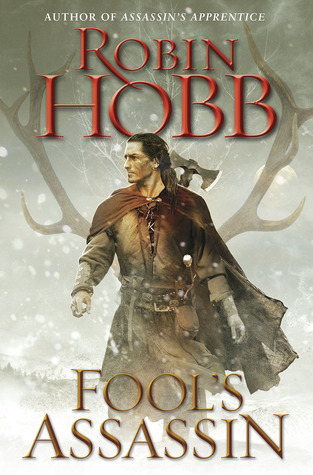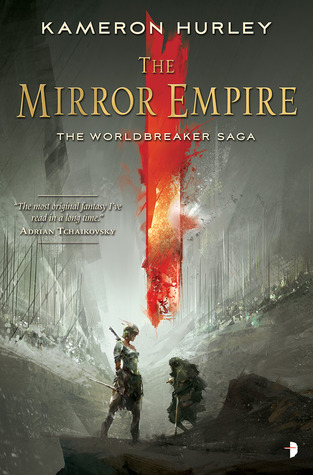About the Author
Wm Henry Morris writes, reads and edits all sorts of fiction with an emphasis on where literary fiction and genre fiction intersect. He can be found at @WmHenryMorris and williamhenrymorris.com.
—
Patience rewarded: The Goblin Emperor, Fool’s Assassin and The Mirror Empire
By Wm Henry Morris
I’ve been thinking about the books I have read so far this year that have stuck with me. One of the ways I judge a book is by how much I’m thinking about it weeks and months after I finish it. Several 2014 titles fall into this category for me (including the books of Jeff VanderMeer’s Southern Reach trilogy), but the more I reflect, the more I’ve come to realize that three of the most enjoyable, lingering experiences for me were reading The Goblin Emperor by Katherine Addison, Fool’s Assassin by Robin Hobb and The Mirror Empire by Kameron Hurley. While all three are fantasy novels, they are very different books and reading experience from each other: the bright stand-alone sweetness of The Goblin Emperor; the slow burn re-starting of a painful, complex relationship in Fool’s Assassin; the thrown-in-the-deep-end, hurtling action series start that is The Mirror Empire. What they have in common, however, is that they all demand patience of the reader.
Books that demand patience don’t always do well in the marketplace. These three titles have made a splash this year in the genre community so clearly they’re finding their audiences. And yet readers have not always reacted positively to the aspects of them that break from the fast-paced plot/transparent prose/straightforward narrative structure that is the dominant mode of genre fiction. This interests me and so I’m going to attempt to briefly explore for each book what the sticking points are — what demands patience of the reader — and then explain why, at least for me, exercising that patience is worthwhile.
Please note that there are middle-of-the-book spoilers ahead for Fool’s Assassin with an oblique nod to the ending. For the other two books I spoil only the basic first-few-chapters info that the marketing copy for them already lays out.
 The Goblin Emperor
The Goblin Emperor
Addison’s The Goblin Emperor has rightly been acclaimed for being a stand alone fantasy novel that is hopeful and full of kindness. The book doesn’t contain much overt action. It’s about Maia, the half-goblin son of an emperor who has been living in exile, attempting to negotiate the perils of court when he ascends to the throne after his father and sibling-heirs are killed in an airship crash. The court machinations and Maia’s success at negotiating them hinge on such small gestures and words and understanding of how and when to flout convention that buying into the stakes of the story requires taking an interest in how the emperor’s court works. But I don’t think that’s what frustrates readers most.
It’s all the names.
Katherine Addison’s steampunkish world of elves and goblins borrows somewhat from 19th century Russia, including the names and titles. And The Goblin Emperor can get just as confusing as a Russian novel as you’re trying to figure out who is being referred to since it seems like every character has at least three or four versions of their name that get used.
But here’s why I think Addison’s use of names is important to the novel and why readers can be rewarded by being patient with them:
When Maia is brought to court, he is in a state of confusion. In spite of his ostensible education at the hands of his court-savvy (but also in exile) cousin, he really is quite clueless about the proper forms and running of an emperor’s quote. The use of names creates a similar state of confusion in the mind of the reader. We can identify with Maia — this whole court business is indeed quite confusing. And if we’re patient and stick with the book, just like Maia is patient and sticks with his decision to ascend to the throne, we begin to better navigate all the names and understand who all the players are. The use of names is there to take the reader on a similar journey as the main character — from confusion to clarity (if not complete fluency).
There is a glossary at the end of the book to help with all the names, but I found that looking things up broke up the flow of reading too much and didn’t really help, so after a couple of uses, I decided to just be patient with book and was rewarded with this mirroring of Maia’s increasing grasp of his situation with my own so that by time the plot climax arrives, I had no difficulty understanding who was who and what they each wanted. And that made those scenes quite delicious.
 Fool’s Assassin
Fool’s Assassin
Remember: major spoilers for the middle section of this book.
Robin Hobb’s Fool’s Assassin requires a very different sort of patience from The Goblin Emperor. As it begins, we are presented with a set of main characters that we know quite well from the previous Fitz and the Fool books, with Fitz once again taking center stage. The only one who is missing is the Fool, and I think most readers suspect, as I did, that there was no question that he would be back. The only question is when the Fool would actually arrive on the page.
But it soon becomes clear that Fool’s Assassin isn’t so much about FitzChivalry and the Fool or Fitz (living in semi-retirement as Tom Badgerlock) and his wife Molly, as it is about Fitz and his daughter Bee, who Molly bears under very strange circumstances and who ends up being a very strange, very smart little girl.
None of that requires much patience. What does is how much time is spent in the middle chapters of the book on Fitz and Bee’s relationship when what most readers want to get to the end where all the action really happens. Instead we have incident after incident where Fitz misunderstands his daughter’s needs and/or how to communicate with her or interpret her words/actions, and she loses trust in him only to have them eventually clear things up and re-forge their father-daughter relationship. At a certain point, the reader may be tempted to say “Okay, I get it!” and skip ahead.
I’m glad that I didn’t. I found it quite touching to experience the variations in the pattern and realize how true to life they ring. Relationships don’t deepen like an after school special where all it takes is overcoming one misunderstanding to make everything okay. Bad patterns don’t improve after one instance of recognition. It takes constant work and refinement, and Hobb gives us this in depth, but with variation, and by being patient with the variation we’re rewarded as readers with how exquisite Hobb, who is a master at portraying relationship, can depict those variations, like the movements of a symphony or the flow of a multi-course meal.
I also think that, especially after what happens at the end of the book, that it’s very important that we have deep experience with Fitz and Bee’s relationship. That extended portrait is likely going to be important as the series moves forward.
 The Mirror Empire
The Mirror Empire
I don’t have one element to point to in The Mirror Empire. It’s more the combination of a bunch of them. Kameron Hurley amps up the requirement for patient reading by throwing in a ton of characters, locations and magic systems — not to mention a spectrum of genders (and the mirror worlds themselves). The reader is dropped in this complex melange and moved through it without ceremony and not a whole lot of scaffolding.
I made the mistake of taking the early chapters slow and at a certain point got rather impatient with the novel. But then I decided to just go with it and exercise both patience and commitment by tackling large swathes of the novel at a time. For me, at least, that worked. By being patient (note that there is a glossary in The Mirror Empire: as with The Goblin Empire, I recommend not using it) and letting the narrative move me forward, I soon found that characters quickly became much less blurry and the various pieces on the board(s) began to assemble themselves in my mind and once I had them in place, the plot became quite exciting as I tried to anticipate how everything was going to collide.
What’s nice about Hurley’s approach is that it doesn’t waste much time with info-dumping and world building. You still get a lot of that packed into the book, but it all comes in the context of the characters themselves and never more than what context they specifically have access to. What’s more, this is also a situation where many of the characters themselves don’t know what’s going on and so the reader moves along with them from confusion to glimmers of recognition to creeping, horrifying awareness. It’s a lovely effect. But it requires being both patient and persistent with the novel.
Not all novels reward patience. Some demand too much for too little reward. And personal tastes differ. I’m not saying that alternate reactions to these three novels are wrong. I can see how what I view as enhancements to the reading experience can be seen as defects.
I am saying that when authors (like the three authors above) know what they are doing, the extra work that they require of the reader is often for a good reason. The pleasures that such work can bring only come if the reader is willing to be patient.
2 Responses
Downbelow Station by Cherryh is my classic example of this phenomenon. (This was years ago that I tried to read it)
After the opening, I found the novel slow, too slow for my tastes. I worked to get through a chapter. I contemplated giving it up as a bad job.
And then the long burning fuse finally went BANG, and I couldn’t read the remainder of the novel fast enough, as I was carried along to the conclusion. Had I never persisted with the slow bits, I’d not have the pleasure of the back end of the book
Downbelow Station is on my to-read pile so thanks for the heads up. I tend to be a patient reader, but it always helps to know that a payoff is looming.